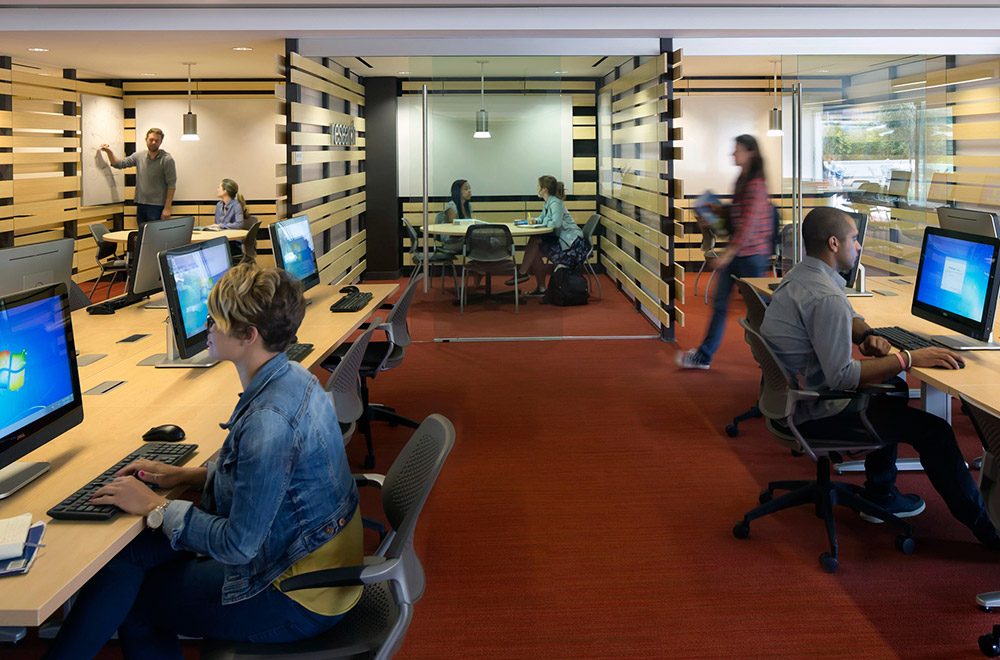Research indicates that architectural design can have a significant impact on people experiencing the built environment.In hospitals, for example, certain design features have been shown to reduce medical errors and the risk of infections. When implemented in schools, design elements can enhance learning, as demonstrated by improved student test scores in math and English. Today, designers are investing in new technology to test these ideas and objectively measure the human response to design.
In an innovative move, California-based HMC Architects is contributing more than $100,000 in cash plus professional services over the next two years to the California Institute for Telecommunications and Information Technology (Calit2). The gift will expand the institute’s multidisciplinary research into human responses to the built environment.
Calit2 at the University of California, San Diego is the home of the StarCAVE virtual-reality environment, a 360-degree, 16-panel, 3-D immersive environment that enables researchers to interact with virtual architectural renderings in three dimensions, in real time and at actual scale.
“This technology ultimately allows us to put the ‘evidence’ into evidence-based design,” said Randy Peterson, FAIA, LEED AP and president and CEO of HMC Architects. “We are looking to develop a system that will give us information to validate the positive effects buildings can have on users of all types—from patients, doctors and visitors in healthcare settings to students, teachers, researchers and the general public in learning environments.”
“We consider the StarCAVE to be a boundary technology that can inform us about how specific features of a building’s design affect human responses, and also yield new insights on how the brain works,” said Calit2’s Eduardo Macagno, founding dean of the UC San Diego Division of Biological Sciences and president of the Academy of Neurosciences for Architecture (ANFA).
Calit2’s research into the effects of design on human cognition and behavior began with its ongoing investigation into “way-finding,” or the process one uses to navigate through architectural spaces. Together with Scott Makeig and Klaus Gramann of the UC San Diego-based Swartz Center for Computational Neuroscience as well as Jürgen Schulze of Calit2 and neuroscientist Eve Edelstein, a visiting scholar at UCSD and senior vice president of research and design with HMC Architects, Macagno and his team are developing an interactive and synchronized VR and electroencephalography (EEG) prototype in the StarCAVE to study the neural structures associated with way-finding.
The research, which was conceived by Macagno after attending a workshop sponsored by ANFA, aims to gain a better understanding of how humans create and use “cognitive maps” of architectural spaces. The researchers also hope to learn which cues are most easily recognized—and therefore the most successful—in helping users navigate through complex buildings.
Calit2 Project Scientist Jürgen Schulze says that the HMC funding will take the research one step further and make it possible for users to modify architectural models in real time within the StarCAVE.
Explains Schulze: “We are going to work with HMC’s architects to find out what the most important editing functions are for them in this environment, and we will implement them for the StarCAVE, where they can be applied much more intuitively than they could on a desktop computer.”
HMC has a growing interest in the neurological implications of architecture. In 2008, the firm hired Edelstein as senior vice president of research and design. Her role is to advise the firm’s architects in the neurological effects of lighting, sound, orientation and architectural designs in education, research and healthcare environments.
The groundbreaking architectural research unfolding in the StarCAVE seeks to demonstrate how evidence-based design can become a method for creating buildings that may save lives and money or improve learning outcomes. By bringing a research-based approach to the art of architecture, designers can learn about the architect’s most discerning critic—the human brain.
In addition to furthering the research at Calit2, HMC’s monetary gift reinforces its continuing partnership with UC San Diego, which hired the firm to design the Preuss School at UCSD. HMC is currently acting as design architect on Phase Two of the University’s Rady School of Management.
